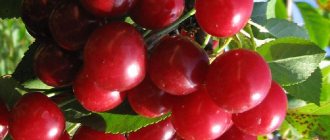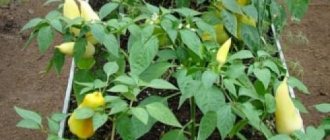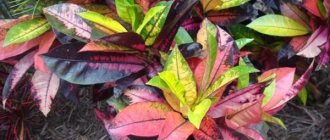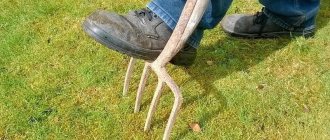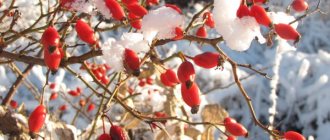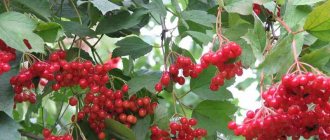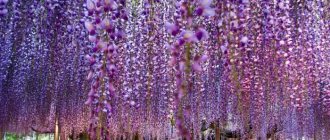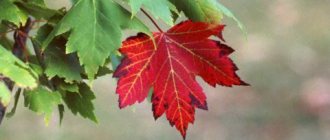Thuja belongs to the ornamental evergreen plant species. The shrub is quite unpretentious in care, but sooner or later every gardener may encounter such a phenomenon as yellowing of the needles. The reasons for the change in plant color can be both natural seasonal changes and pathological processes associated with improper care, diseases or the appearance of pests. The death of the bush can be prevented by promptly identifying and eliminating the negative factors that cause the thuja to turn yellow.
Causes of yellowing of thuja
The reasons for the change in the color of the needles can be determined by the general appearance of the plant, as well as the time of year when this unpleasant phenomenon occurred. In autumn, the color of the thuja may change as a result of natural processes. In this case, only the needles turn red, and the color of the shoots does not change.
Yellowing of the thuja after winter may indicate improper preparation of the plant for the cold. In addition, at the beginning of spring, shrubs often suffer from sunburn, which can also lead to a change in color.
In summer, changes in the color of needles most often occur due to errors in planting and care. If the thuja turns yellow and dries out regardless of the season, and affected areas appear on the shoots, then the cause is most likely various pests or fungal diseases.
Seasonality
Despite the fact that thuja is an evergreen plant, the coniferous cover changes every few years. Signs of needle renewal:
- yellowing is not widespread;
- the change in needles comes from inside the crown;
- shoots look healthy;
- most often occurs in autumn or spring.
In addition, there are species whose crown is initially yellow. These include varieties Golden Smaragd, Yellow Ribbon, Golden Tuffet. Species such as Western or Folded Thuja turn yellow with the onset of cold weather.
Mistakes when transplanting thuja
When planting thuja, you should pay attention to the following points:
- The best soil for thuja is a mixture of turf, sand and peat. The use of peat soil often leads to rotting of the roots. A shrub planted in clay or sandy soil will not be able to fully develop due to an acute lack of nutrients.
- Often the needles turn yellow due to changes in light levels. This happens if the thuja was transplanted from a shaded place or a dense planting.
- If the plantings are too dense, the thujas may turn yellow in places of contact with each other.
- Thuja should not be planted in places where groundwater accumulates or in drafts.
- It is best to plant shrubs in shaded areas of the garden. Open sunny places lead to dehydration of the plant. In the spring, when the snow has not yet melted, the bright sun can cause burns to the needles and young shoots.
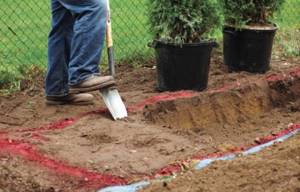
If after planting the thuja begins to dry out and turn yellow, then you need to transplant it to a more suitable place as quickly as possible. After all transplant conditions have been met, proper care and timely pest control will help prevent yellowing of the needles.
Improper care of thuja
The main thing you should pay attention to when caring for shrubs is timely watering and fertilizing. Often thuja begins to turn yellow with excessive amounts of moisture and fertilizer.
Thuja can react negatively to both excess moisture and drying out of the soil. Watering once a week is considered optimal, about 1 bucket per bush. In hot weather, you can double the amount of water.
To prevent thuja planted in a sunny place from drying out, it is recommended to mulch the soil in the circle around the trunk. It is best to use peat or sawdust as mulch.
In hot weather, periodic sprinkling can be done to clean the needles from dust and sand. It is better to carry out the procedure in the evening to avoid causing sunburn.
The first feeding of plants is carried out 2 years after planting the thuja. On average, 2-3 liters of organic fertilizers or 100 grams of mineral fertilizers are used per bush. Thuja does not like fertilizer with manure. As a last resort, you can feed the bush with slurry, infused for at least 10 days and diluted with water.
Diseases
If the thuja's needles suddenly turn yellow and fly off, then the cause may be fungal diseases. Late blight is considered the most dangerous. It settles on the roots and spreads up the trunk, leading to the death of the entire plant. The prerequisites for the appearance of this fungus are excess moisture and stagnation of groundwater.
Signs of late blight:
- looseness of the trunk, especially closer to the roots;
- gray coating on shoots and needles.
Once this type of fungus appears, it will no longer be possible to save the thuja. It is best to dig up and burn the affected shrub, and disinfect or change the soil.
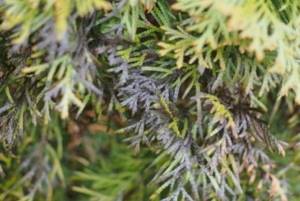
Another common disease of thuja is brown shoots. The disease usually manifests itself in the spring in the form of yellowing of individual shoots. If no measures are taken, the affected branches will gradually turn brown and dry out. For treatment, the affected areas of the thuja are cut off. Until the end of the season, the bush itself is regularly sprayed with foundationazole and sprinkled with limestone.
Pests
Another reason why the thuja turns yellow and dries out can be the activity of various pests. The most common are:
- Thuja aphid. When it appears, the needles begin to sharply turn yellow and fall off. A sign that there are aphids on the thuja may be a large concentration of ants on the trunk or near the plant.
- Spider mite. The presence of a mite is indicated by yellow spots on the needles and the appearance of cobwebs.
- Moth - moth. Its appearance can be detected by the characteristic chewed marks on the shoots of the thuja.
- Leaf roller. Signs of the appearance of this caterpillar are the presence of cobwebs and cocoons on the thuja.
- Bark beetle You can determine the appearance of the pest by characteristic marks on the bark. A tree infected with bark beetle usually dies very quickly.
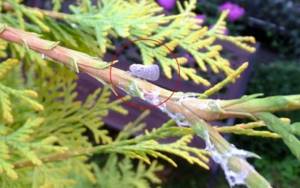
Prevention of pests is timely pruning of thujas, spraying with insecticide and fighting anthills.
Incorrect landing
Yellowing of the thuja, shedding of needles and death of the lower branches, which will subsequently lead to the death of the plant, may be associated with non-compliance with planting recommendations. There are several reasons why a thuja turns yellow due to the fact that the planting conditions were not met.
- Incorrect soil. Clayey, heavy soils do not allow the roots to receive oxygen and inhibit their development. Moisture does not retain in sandy soil and quickly seeps down - the thuja does not receive enough water. When a tree is planted in peat soil in low areas where there is stagnant water, the root system begins to rot, the thuja dries out and dies. To avoid this situation, the soil mixture is selected to be light and nutritious, consisting of turf soil, peat and sand in proportion. It should be remembered that stagnant water is detrimental to thujas, and be sure to provide drainage.
- Incorrect location of the plant's root collar. When it goes deeper into the ground, it rots; when it rises too high above the surface, the roots dry out.
- Small distance between trees. During group plantings, when trees are located too close, they interfere with each other’s development and become sick.
- Poor quality seedling. You need to buy thuja seedlings in specialized stores. The Green Paradise nursery offers only strong, healthy seedlings that take root easily and quickly after planting.
If the reason for the yellowing of the thuja lies in non-compliance with the planting conditions, the only solution is to dig up the plant and replant it, this time following all the recommendations correctly.
How to revive
If the thuja begins to turn yellow, then first of all you need to check how damaged the shoots are. The branches must be carefully bent. If they are dry and brittle, then they must be trimmed and the cut areas treated with varnish or brilliant green.
A young thuja can be revived by transplanting to a more suitable place. In this case, you need to carefully examine the roots of the plant. Rotten and damaged roots must be removed, and the rest must be treated with root.
If the plant is located outdoors, it must be protected from sunlight using a covering material. It is better to move thujas that are indoors to a mini-greenhouse.
To revive a dried plant, you can use the drug “Epina”. It is diluted with water and sprayed onto the thuja crown several times a week, depending on the degree of damage.
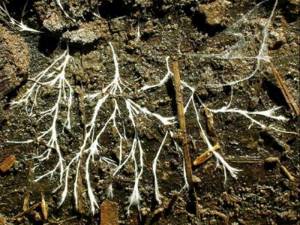
Adding soil with mycorrhiza to the soil will help restore the original color. This is soil from a coniferous forest containing pine needles, spores of fungi and microorganisms. The mixture is scattered in a circle near the trunk, best in the spring.
How to help conifers and protect them from burning
Drying and burns occur in approximately the same period; trees suffer in March and April; due to the climatic conditions of different regions, the exact time of increased solar activity cannot be specified.
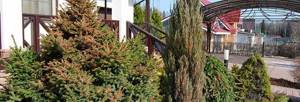
To prevent trees from drying out, it is necessary to take certain measures in the fall:
- Carry out water-recharging irrigation.
- Mulch the surface of the tree trunk circle.
- Apply potassium-phosphorus fertilizers to the trees.
Autumn watering will help saturate the soil under conifers with water, which guarantees a reduction in the phenomenon of drying out. Mulch laid under the trees will prevent moisture from quickly evaporating, and in winter it will serve as insulation for the root system of coniferous trees.
Potassium fertilizers help the plant prepare for winter, so applying them in the fall is mandatory.
If plants are properly prepared for the winter period in the fall, drying out of the crown is not observed.
There are several ways to protect prickly pets from the bright sun.
Prevention of yellowing of thuja
To prevent the thuja from turning yellow, the following preventive measures must be observed:
- control over watering and fertilizing;
- protection from sunburn, drafts, excess moisture;
- regular removal of old and dried shoots;
- soil care in the tree trunk circle;
- prevention of diseases and pests;
- proper shelter for the winter.
If the thuja turns yellow, most often this indicates that something is wrong with it.
Prevention of yellowing and wilting of the bush is proper care and prevention of the appearance of negative factors.
Why do sunburns occur on conifers?
If coniferous trees have not been properly prepared for wintering since the fall, you can expect the appearance of crown burns, which occurs with an increase in solar activity in the first spring month. Sometimes even a few sunny days in February can cause damage to trees.
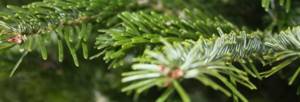
What is the sun's fault? At the beginning of March, the ground is still deeply frozen, the roots of plants cannot extract moisture and transfer it to the branches, and the branches “awakened” by the sun begin to actively develop, which greatly depletes and dehydrates the plants. The growth of new needles requires a lot of moisture, but the mother plant does not receive it from the soil. A lack of moisture at this time leads to drying out of the tree, yellowing and falling off of old needles; areas of the crown oriented to the south and southwest are especially susceptible to this.
Sunburn from the first rays can occur on any type of conifer, cypress, spruce, and some junipers are especially susceptible to this. In spring, the intensity of solar insolation is very high. The risk of burning the crowns of conifers increases when trees are planted near light-colored buildings or fences, as well as when snow cover remains for a long time.
Caring for thuja at different times of the year
Caring for thujas begins after winter, lasts throughout spring and summer, and ends in late autumn. According to many gardeners, the plant is unpretentious and can grow with minimal attention, however, during the growing process a number of significant problems arise: the thuja is dry after winter, has turned black, yellowed after transplanting, how to water it, what to feed it with and what to do about it? There are answers to all these questions; let’s look at the most common and most important ones.
in the photo - yellowed thuja branches
When to open thujas after winter? You should not remove the cover from plants immediately with the appearance of the first rays of the sun, especially for young seedlings growing for the first year. Make sure that the ground around the thuja has thawed and warmed up a little, then remove the covering material. By opening earlier, there is a risk of yellowing of the thuja, since the warm sun will cause the growth of branches and shoots, the root system of the conifer in the frozen soil will be at rest, and water exchange will be disrupted.
What to do if the thuja turns yellow after winter? Before taking active steps, you need to find the cause of the yellowing of green twigs and shoots; there may be several of them:
- Spring burning of the coniferous part of the plant. A fairly common occurrence, to avoid this, plants are shaded already in February, and not in April, when the snow melts. Do not use thick fabrics or fabrics; gauze and mosquito nets are quite suitable. Spunbond is not suitable because it transmits ultraviolet rays, which are most dangerous for thuja in the spring. There is no need to “wrap up” coniferous plants; the greenhouse effect inside will only worsen the condition of the green beauties. If the moment is missed in early spring, water the seedlings with warm water and spray the plants with the biostimulant Ecogel - Antistress to accelerate growth. With the beginning of summer, you will need to cut off the burnt branches;
in the photo - yellowed thuja
If the thuja turns black after winter, it is most likely that a fungal infection has set in. Cut off all bad branches and treat with Hom; if the fungus reappears, treat again. Thuja tree trunks can be watered with another fungicide. The plant may turn black if it is marked by domestic animals; fence the plant and treat it with any fungicide.
In spring and summer, as in autumn, thuja is watered in the same way as after planting, taking into account weather conditions and observing time frames. Feeding thujas begins in early spring and ends in the second half of August, so as not to cause the growth of shoots by winter. In the first year of life, the plants are not fed, then fertilizers are applied as needed. Use complex fertilizers for thujas, such as Osmokot (10-15 grams per bush) or Kemira-Universal (100 grams per 1 m² of planting).
Despite the thuja's resistance to disease, if it is not cared for properly and if there is high humidity, the tree can get sick. Let's figure it out together: what diseases are thuja susceptible to, and how to deal with them?
Not only pests are dangerous for thujas. If not properly cared for and watered, they can be susceptible to disease. It is worth considering the main ones: how they are characteristic, and how to cure your favorite trees from them.
How to save burnt conifers
If the crowns of coniferous trees still receive burns, you should not despair. The most important thing is not to take a saw; you should not remove such branches, but it is necessary to treat the plant.
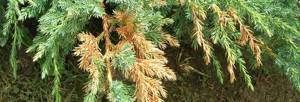
The treatment procedure consists of several stages:
- Freeing the crowns from ice and unmelted snow - carefully clean the tree branches, trying not to damage the needles and bark.
- Watering with warm water is carried out from mid-March. The liquid is heated to a temperature of 38-40 degrees and up to 20 liters of warm water is poured onto each coniferous tree. The procedure is repeated every 2 days for about 2 weeks.
- Application of biological products - the first spraying of the crown is carried out with Epin solution (2 ml/10 l of water). The soil should have time to warm up to +6-8C. 10 days after the first treatment, the plants are sprayed with Zircon solution (1 ml/10 l of water). The same solution is used to water the soil under the plants. The procedure is repeated after 5-7 days, the frequency of treatments with Zircon is from 3 to 5. Finally, the crowns are sprayed with Epin at a concentration of 2 ml per 10 liters of water.
In addition to Epin and Zircon, El-1 preparations can be used to treat coniferous plants from burns; Homeflower; NV-101.
Protective compounds
You can do without installing sun screens; there is an alternative method using special preparations that are sprayed over the crown, create a film and prevent intense evaporation of moisture.
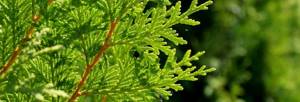
You can use the drug Purshat-O, which is used to treat the crowns of coniferous trees in mid-autumn. It is very important to carry out the treatment before the onset of frost. The procedure is carried out in calm weather at a temperature not lower than -2C.
